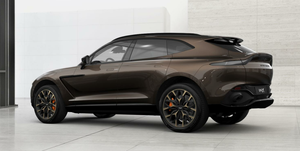Aston Martin might be betting its future on the DBX, but it’s an informed bet. Vehicles such as the Bentley Bentayga and Lamborghini Urus have already taken much of the critical flak over whether or not luxury automakers should be producing SUVs. Not to mention the long-term success of the Porsche Cayenne, which proved that sports-car brands can pivot to SUVs without destroying their credibility. Of course, to succeed in the luxury-SUV market, you still have to build a luxury SUV.
As with Aston’s sports cars, the DBX has a bonded aluminum structure. Also like many of its sports cars, the powertrain comes from Mercedes-Benz. The DBX’s AMG-sourced twin-turbocharged 4.0-liter V-8 pulls duty in the Vantage and base DB11, too. Here it makes 542 horsepower and 516 pound-feet of torque and hooks up to Mercedes’s nine-speed automatic transmission. There is also a quick-acting center coupling to vary the torque sent fore and aft as well as a limited-slip rear differential.
Its power-to-weight ratio puts it behind the Urus but ahead of the Bentayga, so the DBX has more than enough thrust to live in this segment. The V-8 is charismatic, pulling steadily and with unfading enthusiasm all the way to its 7100-rpm redline. The exhaust note is hard-edged and raspy when pressed, with a smattering of pops and bangs on a lifted throttle in Sport and Sport Plus mode.
On the road, its fundamentally rear-driven nature is evident in the punchier dynamic modes. Slippery surfaces turn this rearward torque bias into an outright prejudice against straight lines. The DBX is content going sideways.
Fun as this is, the DBX’s suspension capabilities are more impressive. Standard air springs keep the ride pliant and can raise the ute by up to 1.8 inches or lower it by 2.0. A 48-volt active-anti-roll-bar system ensures that the chassis’s ability to absorb bumps doesn’t affect body control. The DBX remains near flat under sizable g-forces but also digests sizable ruts and potholes.
The interior design and parts are closely related to Aston Martin’s other models’, with the same arrowhead-shaped door releases as the DB11 has and a few Mercedes-sourced bits such as the previous-generation Comand infotainment system that uses a scroll wheel and touchpad. Plus, rear-seat legroom is good enough for adults.
We will have to wait until later this year to drive a production DBX. Our early exposure was of a well-beaten prototype built for durability tests. But it did give us a good idea of what the DBX’s core strengths will be, even if it lacked the plushness that buyers will expect for their near $200,000 buy-in. After suffering big losses in 2019, the company needs the DBX to do well to stay in the game. Aston hopes to sell 4000 DBXs a year, which would represent half the brand’s total production. Given what’s at stake, you don’t need to like the idea of luxury SUVs to understand why this needs to succeed.
Source: Reviews - aranddriver.com





